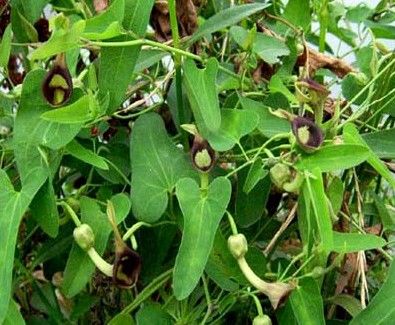Morphological characteristics
1. Northern Birthwort herbaceous vine. Leaves papery; petiole weak, 2-7cm long; leaves ovate-cordate or triangular-cordate, 3-13cm long, 3-10cm wide, apex short or obtuse, base cordate, lobes rounded, saphenous on both sides Or expansion, edge; 5-7. Racemes 2-8 flowers born in leaf axils; peduncles and inflorescence axis very short or nearly absent; peduncles 1-2 cm long, bracteate ovate, with long stalks; perianth 2-3 cm, base expanded Spherical, narrowing upwards and forming a long tube with glandular hairs in the inner mask, and the mouth of the tube is enlarged in a funnel shape; the ankle is very short on one side, sometimes the edge is turned or slightly broken, and the other side gradually expands into a tongue; the tongue Sepals ovate-lanceolate, apex long acuminate with 1-3cm linear and curved tail tip, yellowish green, often with purple longitudinal veins and reticulates; anthers adnate to glucosite column near base; ovary cylinder Shaped, 6-sided; apex of 6-merous column cleft, lobes extending downward into wavy ring. Capsule width obovate or elliptic-obovate, 3-6.5cm long, first Swiss round and slightly concave, 6 edges, mature from the base of the upper 6-lobed; fruit will droop, follow the cracking. The seeds are triangular in heart, flat, with small blemishes, with pale brown membranous wings. Flowering from May to July, fruiting from August to October.

2. Aristolochia vine. Root cylindrical. The stem is weak and hairless. Leaves alternate; petiole long l-2cm, tender; leaf ovate-triangular, oblong-ovate or serpentine, 3-6cm long, base 1.5-3.5cm wide, apex obtuse or shortly acuminate, base cordate, bilateral The lobes are round, sagging or slightly expanded; the basal veins are 5-7, and the veins at all levels are evident on both sides. Flower solitary or two bunches born in leafhoppers; flower length l-1.5cm; small bracts triangular, easy to fall off; perianth 3-5.5cm, base bulge spherical, narrowing up into a long tube, nozzle enlargement Funnel-shaped, yellowish-green, with purple patches on the mouth and glandular hairs on the inside; ankles on one side very short, the other side gradually extending into tongues; tongues ovate-lanceolate, apically obtuse; anthers attached to Helical column near base; cylindrical in the room, 6 edges; apex of the collicular column 6-cleft, slightly papillary, blunt tip of the lobe, extending downward to form a wavy ring. The capsule is subglobose, apex rounded and slightly concave, with 6 edges. When mature, the base begins to crack along the space 6-lobes; the fruit stem is 2.5-5cm long and often torn into 6 pieces. Seeds are flat, blunt triangles, and white lines with broad wings. Flowering from July to August, fruiting from September to October.
In addition to the above-mentioned species, the roots of the plant Aristolochi fulva (the original plant refers to the "Zhushalian") and the roots of Yunnan Tumuxiang are equally used in a few areas, the former being used in Gansu and the latter being used in Yunnan.
The saliva collection device is also called a saliva collector (saliva collector, Saliva Collection Tube, oral sampling tube). The most convenient sampling method for genetic testing is saliva, followed by blood. Currently, the most popular method is to collect saliva samples for testing. , Compared with blood collection, saliva collection is more convenient and free, and the user's acceptance is also higher.

Saliva Collector,Saliva Transport Collector,Toddler Saliva Collector,Saliva Collection Collector
Jiangsu HXRT MD Co.,Ltd , https://www.jshxrtmed.com